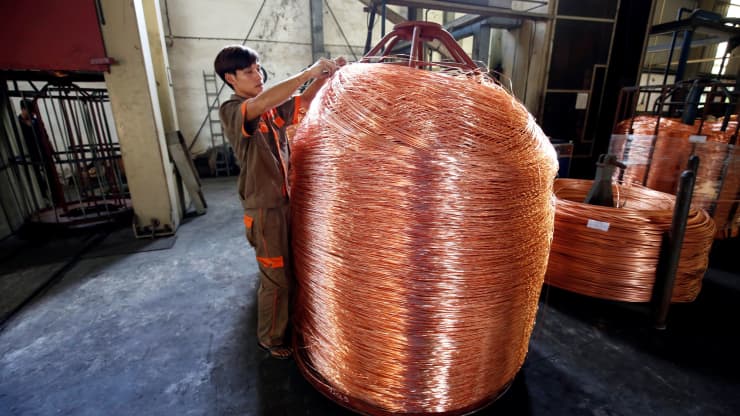
Kham | Reuters
The world risks “running out of copper” amid widening supply and demand deficits, according to Bank of America, and prices could hit $20,000 per metric ton by 2025.
In a note Tuesday, Bank of America commodity strategist Michael Widmer highlighted inventories measured in tons are now at levels seen 15 years ago, implying that stocks currently cover just over three weeks of demand. This comes as the global economy is beginning to open up and reflate.
“Linked to that, we forecast copper market deficits, and further inventory declines, this year and next,” Widmer said.
“With (London Metal Exchange) inventories close to the pinch-point at which time spreads can move violently, there is a risk backwardation, driven by a rally in nearby prices, may increase.”
Backwardation is when an underlying asset is trading at a higher price than the futures market for that asset.
Widmer also highlighted that a rise in volatility resulting from falling inventories was not without precedent, since nickel shortages in LME warehouses in 2006/7 drove nickel prices more than 300% higher.
Given the fundamental environment and the depleted inventories, Widmer suggested that copper may spike to $13,000/t in the coming years after notching $10,000 last week for the first time in a decade.
Copper prices stood at just under $4.54 per pound as of 5:30 a.m. London time on Thursday, up 30% for the session.
After deficits in 2021 and 2022, BofA expects the copper market to rebalance in 2023 and 2024 before fresh shortfalls and a further draw down on inventories kick in from 2025.
“In our view, scrap supply is critical and our analysis suggests that scrap usage at smelters/refiners could increase from around 4,200t in 2016 to 6,700t by 2025,” Widmer said.
“If our expectation of increased supply in secondary material, a non-transparent market, did not materialize, inventories could deplete within the next three years, giving rise to even more violent price swings that could take the red metal above $20,000/t ($9.07/lb).”
‘The new oil’
Along with the broader economic recovery, demand for copper is also being boosted by its vital role in a number of rapidly growing industrial sectors, such as electric vehicle batteries and semiconductor wiring.
David Neuhauser, founder and managing director of U.S. hedge fund Livermore Partners, told CNBC on Wednesday that metals were receiving a general tailwind from a weaker dollar and increasing moves toward green infrastructure.
Commodity prices rose 3% in April, taking the global index up 80% since April 2020, and HSBC commodity analysts highlighted in a note Wednesday that demand for copper is being supported by investment in electrification as emission reduction strategies are further bolstered by policymakers.
Copper remains Livermore’s favorite commodity at present, Neuhauser said.
“I think copper is the new oil and I think copper, for the next five to 10 years, is going to look tremendous with the potential for $20,000 per metric ton,” Neuhauser said.
“We think there are some very solid small cap companies that have massive production potential, and valuations are attractive, and Livermore could make great return on investment.”

